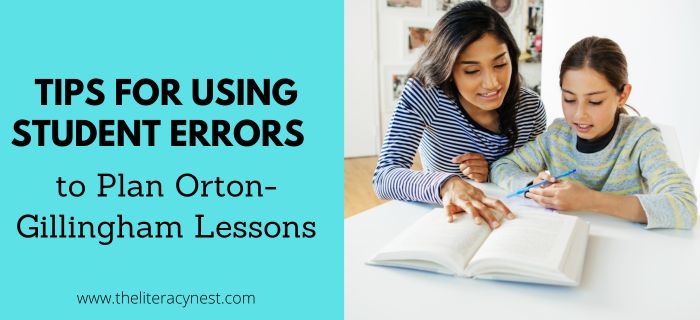Tips for Using Student Errors to Plan Orton-Gillingham Lessons
As Orton Gillingham practitioners, we want to examine student errors in reading and spelling very carefully. According to the OG principles, we are charged with being prescriptive and diagnostic. This involves carefully analyzing student errors, figuring out the root cause of the error, and planning to address that area of difficulty going forward. Simply put, using student errors to plan for future instruction.

You can go through this process for both reading and spelling errors, and it is often helpful to address both decoding and encoding together with prescriptive teaching because reading and writing are reciprocal processes.
There are three basic types of errors that occur in spelling:
1. Phonological error
A phonological error occurs when a student is having some difficulty with sound-symbol correspondence. An excellent example of this might be when a student substitutes i for the short e sound. This could also include omitting a sound or inserting an additional sound.
2. Orthographic error
An orthographic error would be an error with the types of concepts frequently covered by spelling generalizations. For example, if a student didn’t recognize that the word cliff should end in a double f, that is an example of an orthographic error. Another common example would be in the use of ch vs. tch at the end of a word. This would also cover words where the student uses a phonogram that makes the right sound, but a different spelling choice is correct.
Looking for more support teaching spelling generalizations? Check out my FREE sampler for building orthographic Awareness!
3. Morphological error
A morphological error occurs when a student has difficulty identifying and parsing the individual morphemes in a word. For example, spelling the word jumped as jumpt, is an example of a morphological error. The student recorded the sounds in the word correctly but did not correctly identify and write the suffix. Morphological errors may also show up if the student has difficulty using a particular grammatical language structure.
Dig a little deeper! Read, Taking a Closer Look at Spelling Errors: How a Spelling Assessment Can Inform Your Instruction!
When and where does the error occur?

In essence, errors that may occur in reading fall along similar lines. Students may make phonological errors, syllable division or accenting errors, or difficulties breaking the word into morphemes. Analyzing spelling errors is often more helpful because we have a record of the student’s thinking process.
In addition to determining the type of error, we also want to identify the setting or circumstances where the error is occurring. There are often errors that occur in sentence dictation or informal writing that don’t occur in SOS word dictation. Recognizing the pattern of where errors occur can help us target them more deliberately.
Providing Immediate Corrective Feedback
As much as possible, we want to provide immediate corrective feedback. This is important both in terms of ensuring that students do not practice incorrect spellings and in guiding them to develop their metacognitive skills to self-monitor their spelling. This might also be referred to as error correction or error repair. This includes allowing the student to locate and correct the error, as well as practicing the correct form. Dictation is an ideal time to offer this skill. This type of immediate corrective feedback is far more supportive and affirming than a game show buzzer letting them know they made a mistake.
With sentence dictation, I often like to ask students if there are any words they are feeling unsure about. Very often, they have doubts about words in which they made an error, but need a little more guidance to figure out where things went wrong.
Our support will be dependent on the type of error they make. For example:
- For a student who wrote poud for the word pound, I would prompt them to segment the sounds in the word and listen carefully for one that is missing.
- For a suffixing error or morphological difficulty, I would engage in questioning the student to help them identify the relevant morphemes and their corresponding spelling generalizations.
- For a substitution like ee and ea, I will often praise that what the student has written does indeed make the correct sound, but I ask what else could also work in this circumstance.
We are encouraging flexible thinking and the type of analysis we want them to use independently when writing something tricky.
Planning for Future Instruction
After providing immediate corrective feedback, we also want to consider how we can use student errors to plan for future instruction. It is natural to think of simply repeating the word in which the student made the error, but it is more effective and strategic to use different words with similar patterns. If the issue is with adding -ed that says /t/, we might instead of repeating the word jumped, include several different examples such as: pumped, blinked, or limped.
For the student that omitted a consonant in a blend at the end of the word as in misspelling pound as poud, we might include words such as sound or count. Our goal is to create an understanding that is greater than a single word and that students can apply in new situations.
Lastly, we want to be very thoughtful about where in the lesson plan we can provide additional practice on the type of word the student struggled with. A few simple ideas include:
- warmup activity
- quick game
- simply including several examples in spelling and dictation.
Learn more about how I use student errors to plan for future instruction! Watch my video on YouTube, Taking a Closer Look at Spelling Errors!
Orton-Gillingham Spelling Generalizations BUNDLE
Looking for activities for systematic and explicit phonics instruction? This spelling generalization BUNDLE is an effective resource for dyslexic learners or reading intervention. It is a collection of 11 packs. The activities were designed to support Orton-Gillingham lessons and the science of reading.
Are you looking for professional development that will help you better support your students with dyslexia? The Literacy Nest has a membership for that…
Building Readers for Life Academy is a monthly membership program that empowers educators AND families. It dives into structured literacy and strategies for ALL learners. With BRFL Academy, you’ll learn what it takes to help EVERY student become a reader for life.
Join Building Readers for Life Academy today and pay just $1 for your first 30 days! Click here.






